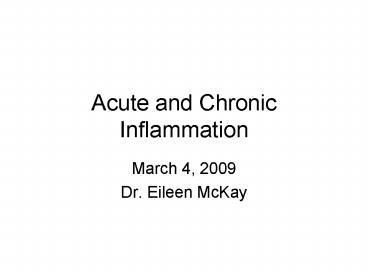Acute and Chronic Inflammation - PowerPoint PPT Presentation
1 / 38
Title: Acute and Chronic Inflammation
1
Acute and Chronic Inflammation
- March 4, 2009
- Dr. Eileen McKay
2
Objectives
- List the five cardinal signs of inflammation.
- Describe the events that occur during acute
inflammation. - List chemical mediators that are involved in
inflammation. - List possible outcomes of acute inflammation.
- Describe the morphology of chronic inflammation.
- Describe the morphology of granulomatous
inflammation. - List causes of granulomatous inflammation.
- Define and differentiate pus, abscess, and ulcer.
- Describe the morphology of an ulcer.
- List the systemic effects of inflammation.
3
Inflammation
- Host response to cellular injury.
- Protective function.
- Harmful effects of unchecked inflammation and
excess tissue damage. - Pharmaceuticals aimed at controlling the host
response.
4
- Acne
- Acute appendicitis
- Otitis media
- Conjuctivitis
- Brain Abscess
- Wound infections
- Chorioamnionitis
5
5 Cardinal Signs of Inflammation
- Dolor pain
- Tumor swelling
- Rubor redness/erythema
- Calor heat
- Functio laesa loss of function
6
(No Transcript)
7
Stage of Acute Inflammation
- Combined VASCULAR response and CELLULAR response
- 1. alterations in vascular caliber that lead to
an increase in blood flow - 2. structural changes in the microvasculature
that permit plasma proteins and leukocytes to
leave the circulation - 3. emigration, accumulation and activation of
leukocytes to eliminate offending agent
8
ACUTE INFLAMMATION
- VASCULAR REACTION
- Vasodilation
- Increased permeability
- Stasis
- Leukocyte accumulation
- CELLULAR REACTION
- Leukocyte extravasation
- Margination
- Diapedesis
- migration
- Leukocyte activation
- Phagocytosis
- Termination of inflammatory response clean up
9
Mechanisms for Increased Vascular Permeability
- Gaps due to endothelial contraction
- Direct injury
- Leukocyte-dependent injury
- Increased transcytosis
- New blood vessel formation
10
(No Transcript)
11
NEUTROPHILS
12
(No Transcript)
13
Chemical Mediators
14
Systemic Effects of Acute Inflammation
15
Evaluating a Patient for Acute Inflammation
- Superficial inflammation
- Pain, swelling, erythema
- Loss of function
- Generalized fatigue
- Loss of appetite
- Systemic signs
- Vital signs
- Fever
- Increased pulse and heart rate
- Laboratory investigations
- Elevated white blood cell count and left shift
- Acute-phase reactants
16
Neutrophil left shift or bandemia
17
Outcomes of Acute Inflammation
- Complete resolution
- Abscess formation
- Chronic inflammation
- Scar formation
18
Morphologic Patterns of Acute Inflammation
- Serous inflammation
- Fibrinous inflammation
- Suppurative/purulent inflammation
- Ulcerative inflammation
19
Serous Inflammation example blister
20
Edema and Fluid Collections
- Exudate
- Associated with acute inflammation
- Increased vascular permeability
- Specific gravity gt 1.020
- Protein and cellular debris present due to
increased vascular permeability
- Transudate
- No change in vascular permeability
- Specific gravity lt 1.012
- No increase in protein concentration
- Occurs with osmotic or hydrostatic imbalance in
vascular compartment (ie. nephrotic syndrome)
21
Fibrinous Inflammation example fibrinous
pericarditis
22
Suppurative/purulent inflammation example
acute appendicitis
23
Another example Bacterial pneumonia
24
(No Transcript)
25
(No Transcript)
26
Ulcerative inflammation example gastric ulcer
27
(No Transcript)
28
Acute vs Chronic Inflammation
- Acute inflammation is a more rapid event with
shorter duration. - Cannot be ignored
- Chronic inflammation is delayed and prolonged.
- May follow acute inflammation or arise de novo as
a low grade process - May be asymptomatic
- Associated with tissue destruction/ architectural
changes with angiogenesis and possibly fibrosis.
29
(No Transcript)
30
Morphology of Chronic Inflammation
- Characterized by mononuclear infiltrate with
macrophages, lymphocytes, and plasma cells.
31
Acute vs Chronic Inflammation
32
Granulomatous Inflammation
- Granulomas can be necrotizing or non-necrotizing.
- Consist of aggregates of histiocytes/activated
macrophages with eventual formation of external
collar of lymphocytes. - Multinucleated giant cells may be present.
- Response to injurious agents that cannot be
successfully eradicated by humoral and cellular
immune reactions.
33
Causes of Granulomatous Inflammation
- Organisms
- Mycobacteria
- Cat- scratch disease
- Leprosy
- Brucellosis
- Syphilis
- Mycotic infections
- Lymphogranuloma inguinale
- Foreign Bodies
- Irritant lipids
- Berylliosis
- Autoimmune disorders
- Crohns disease
- Sarcoidosis
34
(No Transcript)
35
(No Transcript)
36
(No Transcript)
37
(No Transcript)
38
(No Transcript)































